Smooth Creations is a premier boutique system builder responsible for some of the astonishing cases we’ve ever seen. We’ve taken a look at one of its value-oriented systems in our latest review.
We recently previewed the Smooth Creations Trek 08 custom paint job that featured some insane graphic talent that had been applied like a fine hotrod of yesteryear. Unlike a true hotrod, however, it did not attract any scantily-clad women at the beach. But, I didn’t exactly truck the case out to the beach. And my wife might object to cruising for … never mind. I haven’t been to the beaches in ages anyway. Suffice it to say that the hotrod here in question never saw the outdoors, but did get lots of action in the form of gaming and benchmarking. Exciting stuff!!
For those of you who may not have heard of Smooth Creations, you have probably seen photos of their work around the Web, particularly in coverage of the various tradeshows and conventions. Founded in 1999 by an automotive finishing expert, Smooth Creations is a company that specializes in custom artwork on computer cases and they detail cases just like a hotrod car: all paints used are automotive basecoats/clearcoats. They have teamed up with Diamond Multimedia to produce custom gaming systems for consumers who crave something out of the ordinary. Diamond Multimedia is a widely recognized company in the fields of graphics, sound and communications, and associated multimedia technologies. They carry a full line of graphics cards and specialize in high-performance products.
After our initial look at the Trek 08 from the outside, admiring the airbrush work and reflections in the clearcoats, it was time to pop the hood and see what powered this beast. Ladies and gentlemen, start your engines.
The specifications for the Trek 08 as follows:
| Smooth Creations Trek 08 | |
| Case | Zalman GS1000 |
| Processor | Intel Core 2 Quad Q9650 @ 3.0GHz |
| Motherboard | Foxconn P45-A-S |
| Memory | 2 x 2GB G.Skill PC2-6400 @ 6-6-6-18 |
| Graphics | Diamond Radeon 4870 |
| Power Supply | Coolermaster Real Power Pro 1000w |
| Heatsink Cooler | Zalman CNPS 9700 NT |
| Hard Drive | Western Digital 150GB Raptor |
| DVD-RW | Lite-On DH20A |
| Operating System | Windows XP 32-bit |
| Price | $3,100 US |
We should mention that test system we received had slightly different hardware specifications: our hard drive was a 1TB Western Digital Green Power and our power supply was a Zalman ZM1000-HP. These won’t adversely affect the benchmark tests very much, with the actual Trek 08 including a Raptor drive so customers can expect faster load times with that. The one major difference, however, in our test system was the absence of Windows Vista. The operating system we received was Windows XP. This was a disappointment, as a rig with this horsepower truly needs to run Vista in order to experience DX10 gaming and other improvements that are brought to the table. That being said, you can count on Vista being installed in your Smooth Creations system, but we only mention it here because it did preclude us from running certain benchmarks we had intended, such as 3DMark Vantage, and DX10 game settings in games like Crysis.
[Editor’s note: The reason this particular system had Windows XP was because the graphics card was not working perfectly under Windows Vista. This has been fixed. Smooth Creations also informed us that the PSU was overheating when installed as the case was designed, this has also been remedied.]I won’t go into great depth here discussing the exterior of the system because most of that was already examined in our preview. As you can see, the artwork and quality is exceptional, with a real depth that is visible through the clearcoats of the paint. On this particular case, the artwork is identical on both the left and right sides of the case. This case is really top notch work; the detailing is excellent, color separation is clear and distinguishable with no bleeding or careless edges, and the paint coverage extends fully across the panels on very tight tolerances.
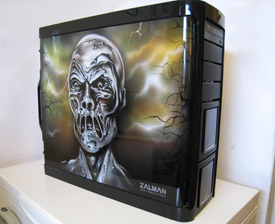 |
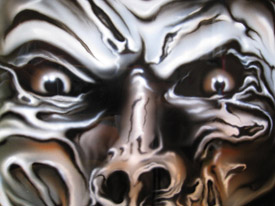 |
The front of the case features 4 – 5.25″ drive bays and no external 3.5″ bays. The on/off button depresses very nicely with a solid “click” and is surrounded by an illuminated blue LED with the system is powered on. There is no Reset switch, however, which is a bit odd. I know I use a reset button on occasion when I get the rare lock-up. At the rear of the case we see 1 – 120mm exhaust fan, rubber grommets for water cooling tubes if you decide to go in that directions, and a bottom-mounted power supply that is removable via an attached plate.
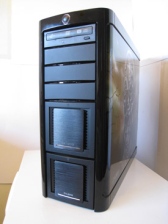 |
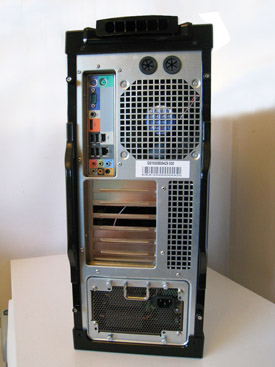 |
The choice of case itself to customize, the Zalman GS1000 is a bit of an interesting selection in my opinion. It is undoubtedly a quality case with a glossy piano finish, accenting the paint job very nicely. However, it is also a case that is lacking any front intake fans or dust filters, and is very "plasticky" along the edges. What struck me as odd, though, was the lack of feet on the bottom of the case that should be part of the Zalman case design. The feet are necessary to raise the case off the ground in order for ventilation through the bottom of the case, which is extensively perforated and case function as intake points for air circulation into the case. The case also features a bottom-mounted power supply which should be sucking fresh, cool air inside from the bottom of the case. This cannot happen with the case sitting flush to the floor or desk, making me wonder how the power supply would be getting fresh air then? A quick removal of the power supply plate and a little pull gives the answer: the power supply has been installed upside-down. Certainly this is not an ideal situation, with the power supply intaking warm case air next to the graphics card.
We continue on the next page.
Considering the lack of intake fans at the front and the bottom of the case, this effectively reduces the ventilation this case to a passive air circulation setup. The top of the case does have an elevated panel that creates openings to exhaust warm air outward, but for a high-end gaming system that would be prone to producing a great deal of heat, I would be concerned about this lack of active ventilation.
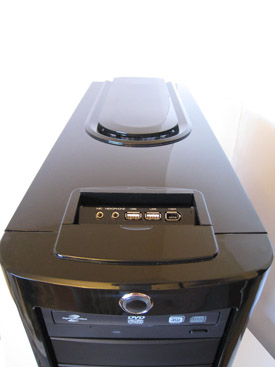 |
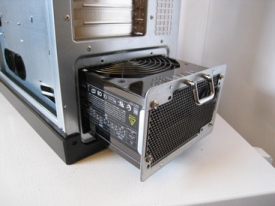 |
The front of the case features two soft-eject drive doors that house the hotswap drive setup. Only the bottom 3 bays, however are hotswap, and the top 3 are a traditional SATA setup, though the drive bay caddies are still available. The drive bay caddies themselves are a nice design, easy to remove by squeezing the housing and simply pulling the drive out the front.
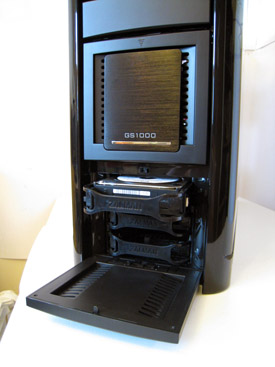 |
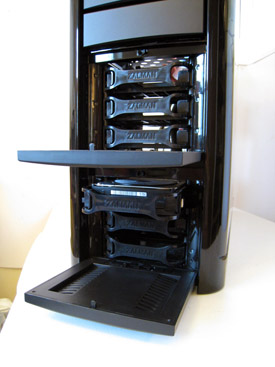 |
Let’s move inside the belly of the beast now….
Removing the side panels is a very easy task, as the GS1000 has spring-loaded screws which stay attached to the panels themselves and won’t therefore become easily lost. Fully removing the panels, we see the interior of the systems on the left and right sides. Overall, the case is quite roomy and provides several holes in the motherboard tray to route the system cables, though that hasn’t been done here. I’m a bit surprised that the cable management is a bit haphazard, especially considering this system is boutique-built. The exterior of the case is impeccable, but unfortunately the interior isn’t quite as successful.
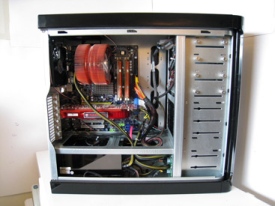 |
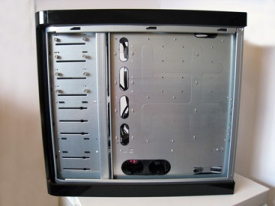 |
A closer look reveals the motherboard is a Foxconn P45A, not the top dog in the market but certainly decent nonetheless, with solid BIOS options and enough slots to keep a gamer pleased. It does have a weak Northbridge heatsink, so I wouldn’t expect any hardcore overclocking from this board unless you plan on adding some additional aftermarket cooling. The 4 GB of G.Skill memory features 6-6-6-18 timings, which is rather relaxed, but this shouldn’t pose much issue in a gaming setup such as this. A Zalman CNPS 9700 will keep the Q9650 CPU cool very nicely, though it is not a silent heatsink by any stretch. Certainly not a problem, but it doesn’t complement the silent fans nor power supply very well. Above the motherboard we see 2 – 120mm fan slots which help exhaust the heat out the top of the case. Interestingly, this is a perfect setup waiting to take on a 240mm radiator for a water cooling setup. The bottom contains the kilowatt Zalman power supply, unfortunately installed upside-down. When the system is running, this power supply is silent. In fact, the entire system runs quiet, with the Zalman 9700 CPU heatsink actually being the loudest component in the entire setup.
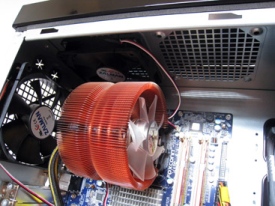 |
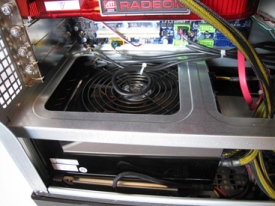 |
At the bottom of the case we see the hotswap drive board, with Molex and SATA connectors. Above this, at the front of the interior we see the IDE drive, which is an interesting choice given the multitude of SATA slots available. Here we also see the Trek 08 houses a Diamond Radeon 4870 XOC, which is overclocked to 800 / 1100 MHz, up from the reference card’s 700 / 900, a very good increase with the GDDR5 being used in this card.
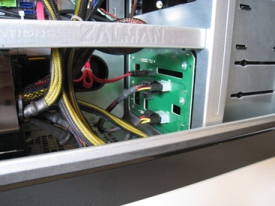 |
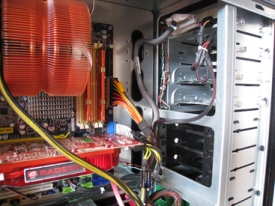 |
Firing up the Trek 08, I jumped into the Foxconn BIOS to take a quick look at some of the available features and setups. The BIOS is not a tweaker’s dream, but it is fully capable of pushing the 9650 if you are so inclined. Should you have the desire to overclock the Q9650, then you should easily achieve a moderate overclock with the stock motherboard and CPU cooling in the system. Leaving the BIOS, it was time to get moving and start testing and gaming! Next I was greeted by the Windows XP loadscreen. XP?! After the initial surprise, I was quite shocked when it finally sunk in. A system of this caliber should have Vista installed to take advantage of the DirectX 10 horsepower provided here. Putting XP on a system of this pedigree is like painting a Ferrari in stripes; it’s foolish. This meant no 3DMark Vantage testing, no Crysis testing on Very High, and any other eye candy I was hoping to check out.
Well, the show must go on as they say, so chin up and play the hand you’re dealt. After questioning Smooth Creations about this, they indicated that they intend on providing Windows Vista for the Trek 08, so there’s certainly a silver lining to all this, but I was a wee bit disappointed I couldn’t truly push the horsepower in this system.
First off, we’ll run through some general synthetic benchmarks. The Trek 08 is no doubt a gaming rig, and while these tests are not exactly "real world" ones, they do reflect some very popular benchmarks in the enthusiast community. Another factor here that is important to note is that with a system such as this, we won’t baby it. We’re going to run gaming tests with all the eye candy enabled and find the "highest playable" settings we can. While many gamers still play at 1280 x 1024 resolution, testing this system at that level would be a crime. So we’ll be using 1680 x 1050 resolution, which represents probably the most popular current standard for gamers today. This resolution is typically found on 22" LCD monitors, which are extremely popular and inexpensive in today’s market.
With that explained, let’s move onto the testing. Here we have 3 very popular synthetic benchmark tests: 3DMark06, Super-Pi, and Cinebench 10. These programs primarily test the CPU, with 3DMark06 also evaluating the graphics capability of a system. The results are as follows:
"Common system" sports an Intel Core 2 Duo E8400 (3.0 GHz), 2GB PC6400 RAM and GeForce 8800GT for graphics.
Let’s now move onto the gaming tests.
First and foremost, the Trek 08 is a gaming rig, make no mistake. It houses some very good hardware and is built for speed.
Call of Duty 4 & Race Driver: GRID
Call of Duty 4: Modern Combat and Race Driver: GRID are two very popular games that are shader-intensive and feature beautiful graphics, striking lighting and contrasts, shadows, and fast-paced action. These are games that can push a system when the graphics settings are cranked up.
WORLD IN CONFLICT, CRYSIS
World in Conflict is a real-time strategy game that is very graphics-intensive and can also punish a CPU. For an RTS game, World in Conflict is a graphical gem, with eye-popping explosions and a ton of action on your screen. Crysis is the game that is known as the PC-killer. It can cripple even the most advanced system in today’s market. With absolutely breathtaking graphics, advanced physics, lighting, and shadows, running above 1280 resolution with antialiasing enabled often results in a slideshow when gaming.
QUAKE WARS, UNREAL TOURNAMENT 3
Enemy Territory: Quake Wars and Unreal Tournament 3 are two games that are slightly older now, but still popular nonetheless. UT3 also features the Unreal Engine, which is extremely popular in many of today’s top games, and it also pushes a CPU more than most games. These games are very fast-paced first person shooters that rely on high framerates to be successful in the multiplayer servers.
The bottom line here is that this system puts up some great numbers across the board. In fact, the Trek 08 chewed through every game at 1680 resolution at max settings except for Crysis, which is to be expected. It tore through CoD4 in a full server on Deathmatch, posted consistent frames in the RTS World in Conflict, and utterly blew away Quake Wars and Unreal 3. Performance in GRID was particularly impressive, as it ran absolutely smooth in heavy race traffic with Ultra High settings and looked simply stunning. As a gaming rig, the Trek 08 was indeed a beast and based on the numbers, I would venture a bet that this system will also comfortably play at 1920 resolution.
It’s not everyday that I get to test a system like this one, so when this Smooth Creations system arrived, I must admit I was like a impatient child on Christmas Eve and dropped everything to open the box. Apparently someone thought I wasn’t a bad kid and didn’t send coal; instead I was greeted with a gem of system, a true work of art. There likely aren’t enough superlatives to describe the artwork and talent put into the custom paint job on this case, so I won’t bother trying because I’ll end up sounding like a blathering idiot. The fact of the matter is this gaming system posts some excellent performance results, in a quiet setup, in a case that will set you apart from the rest. It easily handled any game we threw at it with all the eye candy cranked up (Crysis being the exception, although it did perform well at 1280 resolution).
While there were a few issues with the build, notably the power supply that was installed upside-down and the lackluster cable management, they are certainly not deal-breakers by any means. The remainder of the system was top-notch, and the attention to detail was impressive.The only thing that really concerned me was what all this potentially cost to consumers…err…clients. When I inquired about the cost of the system, I was pleasantly surprised to find a $3,100 US price tag; honestly, I was expecting considerably higher. One can never easily put a simple price on art, and this system is no exception, but the performance provided in this system offers surprisingly good value for your hard-earned dollar. It appears that Smooth Creations has managed to carve into a potentially lucrative market segment that offers a boutique build at a very reasonable price.
It is often a daunting task to live up to the hype when finally staring it in the face, and in this case, quite literally. Smooth Creations and the Trek 08 does just that.

|
|
Smooth Creations Trek 08
|
|
Pros
Cons |
Our thanks go to Smooth Creations and Diamond Multimedia for providing the Trek 08 for this review.


















